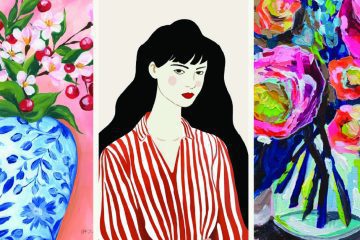In modern graphic design styles, it’s easy to spot the influence of classic artists like Van Gogh, Dali, and Warhol. Their unique ways of seeing the world have quietly shaped how designers think about colour, form, and storytelling today.
What started as fine art has now become part of the everyday design world, showing up in places most of us wouldn’t expect. That blend of traditional art with new-age creativity helps define what modern graphic design styles are all about.
This connection between past and present gives design a sense of depth. Even basic designs can feel more powerful when they carry hints of artistic influence, whether we notice it or not.
Graphic Design Inspired by the Greatest Artists
A lot of what you see in today’s design pulls from artists like Dali and Warhol. That dreamy, almost unreal style? It feels a lot like something out of Salvador Dali’s world. Those loud, vibrant visuals that grab your attention right away? They’ve got Warhol written all over them.
Still, it doesn’t stop there! A lot of other artists have helped shape what modern graphic design looks like, even if we don’t always realise it. You might be surprised where their influence pops up. Let’s dig into how their work still finds its way into the designs we see all around us.
- Van Gogh: Turning Up the Color
Ever wondered why some designs seem to pull you in instantly? A lot of that spark comes from how colors are used. You could say it started with Van Gogh. He didn’t play it safe with soft or neutral shades.
Instead, he threw bold opposites together—blue and orange, red and green. It created this buzz, a kind of energy that still shows up in modern design. Today’s ads and apps often use those same punchy combos to catch your eye. It’s not only about looking good; it’s about standing out fast.
- Saul Bass and Paul Klee: Simple Shapes That Stick
Saul Bass worked with some of the biggest names out there, and his designs were always sharp and simple. What’s cool is that his style was kind of a throwback to Paul Klee, who played around with basic shapes and blocks of color. Klee’s art had a quiet charm. It was subtle, yet unforgettable. Bass seemed to get that less can actually mean more. That idea stuck! Now, you’ll see logos that use the same kind of clean, blocky layout. This kind of minimalism comes across as smart rather than sterile.
Check Out: A Look at Modern Creative Trends in Graphic Design
- Andy Warhol: Pop Culture Meets Design
You know those loud, repetitive visuals in ads or music covers? Warhol helped bring that to life. He took everyday stuff—like soup cans or celebs—and made it art. His work was flashy, repetitive, and impossible to ignore. Today, designers still lean on that formula. The modern designs often carry echoes of the past, with bold colors, recurring visuals, and a fun, creative twist. Even streetwear brands and social media graphics use tricks Warhol made popular. He turned creative flair into something marketable.
- Dali: Design That Feels Like a Dream
Salvador Dali didn’t paint like anyone else. His art felt like stepping into a strange dream, where nothing made sense but everything felt important. Designers have borrowed that idea too. They mix unexpected images, twist reality, or use soft shadows and floating shapes to give designs a surreal vibe. You’ll see it in album art, fashion ads, and sometimes even in web design, where things move in surprising ways. It’s not always about clarity. Sometimes, weird just works.
- Matisse: Cutouts, Color, and Feeling Alive
Henri Matisse started doing colorful paper cutouts later in his career, and they had this loose, hand-made look that feels totally modern. You’ll see flat forms, confident colours, and a clear-cut look that skips the fluff. A lot of today’s design—especially in packaging and editorial art—follows that same energy. It doesn’t try to be perfect. It’s bold, full of colour, and has a personal touch that makes it more fun to take in.
- Kandinsky: Turning Design into Music
Kandinsky thought art could move like music. He didn’t just paint pictures—he created rhythm using shapes and colors that hit you on a deeper level. That idea really clicked with digital designers. These days, it’s not just about making things look neat on a screen. It’s like your eyes are following a rhythm, just the way they would with music. The goal? It’s about creating emotion, even when all you see are shapes and empty space.
Summing Up
Modern graphic design might seem fresh and cutting-edge, but it actually reaches far into the past. Those bold colours you see in modern design? That’s Van Gogh whispering through the screen. And the way layouts seem to flow? Kandinsky had a hand in that rhythm. These artists didn’t create on screens. They used canvas, pouring bold and sometimes messy ideas into their work that changed how people saw the world. Even now, in a time of endless scrolling, their mark is still there. What parts of history do you see in your favorite visuals? Share with us!



0 Comments